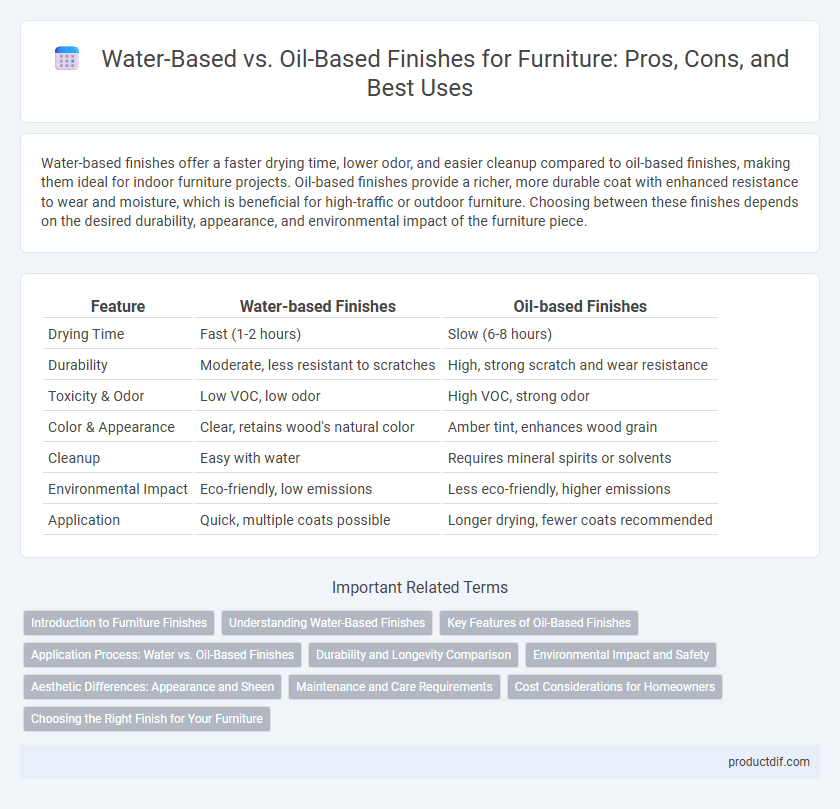Water-based finishes offer a faster drying time, lower odor, and easier cleanup compared to oil-based finishes, making them ideal for indoor furniture projects. Oil-based finishes provide a richer, more durable coat with enhanced resistance to wear and moisture, which is beneficial for high-traffic or outdoor furniture. Choosing between these finishes depends on the desired durability, appearance, and environmental impact of the furniture piece.
Table of Comparison
| Feature | Water-based Finishes | Oil-based Finishes |
|---|---|---|
| Drying Time | Fast (1-2 hours) | Slow (6-8 hours) |
| Durability | Moderate, less resistant to scratches | High, strong scratch and wear resistance |
| Toxicity & Odor | Low VOC, low odor | High VOC, strong odor |
| Color & Appearance | Clear, retains wood's natural color | Amber tint, enhances wood grain |
| Cleanup | Easy with water | Requires mineral spirits or solvents |
| Environmental Impact | Eco-friendly, low emissions | Less eco-friendly, higher emissions |
| Application | Quick, multiple coats possible | Longer drying, fewer coats recommended |
Introduction to Furniture Finishes
Water-based finishes offer rapid drying times and low VOC emissions, making them an eco-friendly choice for furniture preservation. Oil-based finishes provide deep penetration and enhanced durability, ideal for high-traffic furniture pieces requiring long-lasting protection. Selecting between these finishes depends on desired appearance, environmental impact, and maintenance requirements.
Understanding Water-Based Finishes
Water-based finishes offer low VOC emissions, quick drying times, and easy cleanup with soap and water, making them environmentally friendly and user-safe options for furniture. These finishes provide a clear, non-yellowing coat that maintains the natural color of wood while enhancing durability and resistance to scratches and moisture. Ideal for indoor furniture, water-based finishes are favored for their transparency and ability to retain the wood's original appearance over time.
Key Features of Oil-Based Finishes
Oil-based finishes provide a durable, hard-wearing surface ideal for high-traffic furniture, enhancing the wood's natural grain with a rich, amber tone. These finishes are resistant to water, chemicals, and heat, ensuring long-lasting protection and a smooth, glossy appearance. They cure slowly, allowing for deep penetration into the wood fibers, which improves adhesion and durability over time.
Application Process: Water vs. Oil-Based Finishes
Water-based finishes dry faster and emit fewer volatile organic compounds (VOCs), making them ideal for indoor furniture with quick turnaround times. Oil-based finishes penetrate deeply into wood fibers, providing a durable and rich finish but require longer drying and curing periods. Choosing between water and oil-based finishes depends on the desired durability, appearance, and environmental considerations during application.
Durability and Longevity Comparison
Water-based finishes offer excellent durability with superior resistance to yellowing and UV damage, making them ideal for maintaining color integrity over time. Oil-based finishes provide a thicker, more robust protective layer that enhances wood's natural grain while offering longer-lasting protection against scratches and wear. For longevity, oil-based finishes typically require less frequent reapplication, but water-based options are prized for faster drying times and reduced environmental impact.
Environmental Impact and Safety
Water-based finishes emit significantly lower volatile organic compounds (VOCs) compared to oil-based finishes, reducing air pollution and health risks during application. These finishes dry faster and are less flammable, enhancing safety for both artisans and consumers. Oil-based finishes, while durable, release higher VOC levels and contain hazardous solvents that pose greater environmental and indoor air quality concerns.
Aesthetic Differences: Appearance and Sheen
Water-based finishes provide a clear, natural appearance with minimal ambering, preserving the wood's original color and grain patterns for a modern, crisp aesthetic. Oil-based finishes impart a warm, amber tone that enhances wood grain depth and richness, creating a classic, vintage look with a glossy or semi-gloss sheen. The choice between water-based and oil-based finishes directly affects the furniture's overall ambiance, from bright and contemporary to warm and traditional.
Maintenance and Care Requirements
Water-based finishes require minimal maintenance, offering excellent resistance to yellowing and easy cleaning with mild soap and water, making them ideal for high-use furniture. Oil-based finishes demand more frequent upkeep due to their tendency to darken and wear over time, often needing reapplication of oil or wax to maintain durability and luster. Proper ventilation is essential during application for both finishes, but water-based options cure faster, reducing downtime for furniture use.
Cost Considerations for Homeowners
Water-based finishes generally cost less upfront compared to oil-based finishes, making them a budget-friendly option for homeowners seeking affordable furniture protection. Oil-based finishes tend to be pricier due to their longer drying times and greater durability, which can lead to fewer refinishing needs over time. Homeowners should weigh initial costs against long-term maintenance expenses to determine the most cost-effective choice for their furniture preservation.
Choosing the Right Finish for Your Furniture
Water-based finishes offer quick drying times, low odor, and eco-friendly properties, making them ideal for indoor furniture or surfaces requiring frequent use. Oil-based finishes provide a durable, rich amber tone and deeper penetration into wood fibers, perfect for hardwood furniture exposed to heavy wear. Selecting the right finish depends on factors like desired appearance, durability needs, drying time, and environmental considerations.
Water-based Finishes vs Oil-based Finishes Infographic

 productdif.com
productdif.com